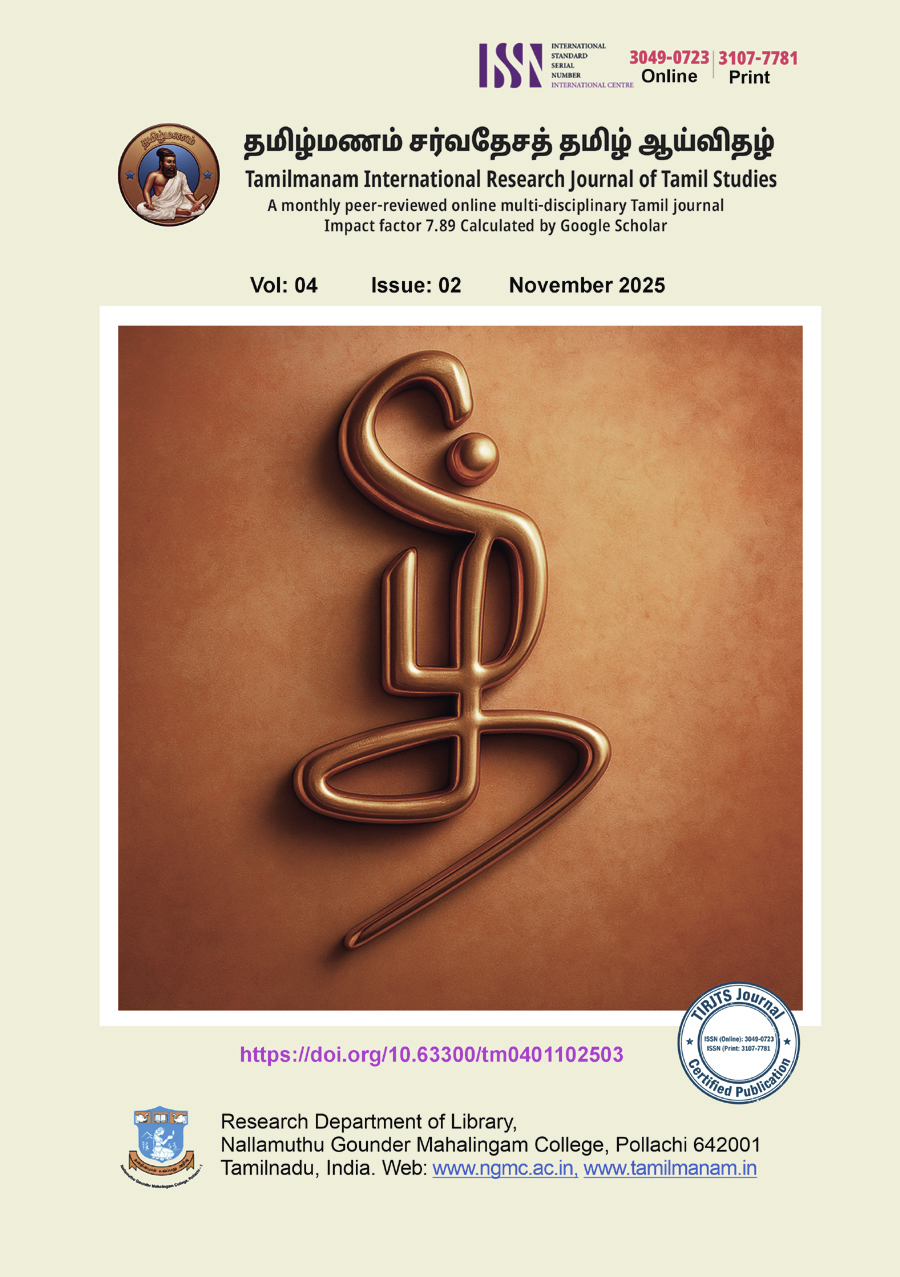Cognitive Processing and Conceptualization in Tamil: A Psycholinguistic Review
தமிழில் அறிவாற்றல் செயலாக்கம் மற்றும் கருத்தாக்கம்: ஒரு உளவியல் மொழியியல் மதிப்பாய்வு
DOI:
https://doi.org/10.63300/tm0402112517Keywords:
Tamil, psycholinguistics, cognition, linguistic relativity, bilingualism, cultural psychologyAbstract
Language has a significant impact on cognition, influencing how people perceive, categories, and emotionally understand the environment. One of the oldest surviving classical languages in the world, Tamil provides a useful foundation for investigating psycholinguistic phenomena outside of Indo-European contexts. To understand how Tamil's linguistic structures, including agglutinative morphology, contextual tense systems, and culturally embedded semantics affect cognitive processing and conceptualization, this review synthesizes the existing body of theoretical and empirical research. This review identifies possible ways that Tamil influences temporal, affective, and social cognition by integrating viewpoints from language relativity, cultural psychology, and bilingual cognition. It draws attention to existing research gaps and suggests avenues for further multidisciplinary investigation. According to research, Tamil's grammatical and cultural systems have an impact on how its speakers perceive the world, demonstrating the close connection between language, culture, and mind.
மொழி அறிவாற்றலை ஆழமாக வடிவமைக்கிறது, அதன் தாக்கம் தனிநபர்கள் உலகை எவ்வாறு உணர்கிறார்கள், வகைப்படுத்துகிறார்கள் மற்றும் உணர்வுபூர்வமாக விளக்குகிறார்கள். உலகின் பழமையான வாழும் செவ்வியல் மொழிகளில் ஒன்றான தமிழ், இந்தோ-ஐரோப்பிய கட்டமைப்புகளுக்கு அப்பால் உளவியல் மொழியியல் நிகழ்வுகளை ஆராய்வதற்கு ஒரு மதிப்புமிக்க சூழலை வழங்குகிறது. தமிழின் மொழியியல் கட்டமைப்புகள் - திரட்டு உருவவியல், சூழல் சார்ந்த கால அமைப்புகள் மற்றும் கலாச்சார ரீதியாக உட்பொதிக்கப்பட்ட சொற்பொருள் - அறிவாற்றல் செயலாக்கம் மற்றும் கருத்தாக்கத்தை எவ்வாறு பாதிக்கிறது என்பதைப் புரிந்துகொள்ள, இந்த மதிப்பாய்வு ஏற்கனவே உள்ள தத்துவார்த்த மற்றும் அனுபவ இலக்கியங்களை ஒருங்கிணைக்கிறது. மொழியியல் சார்பியல், கலாச்சார உளவியல் மற்றும் இருமொழி அறிவாற்றல் ஆகியவற்றின் கண்ணோட்டங்களை ஒருங்கிணைத்து, இந்த மதிப்பாய்வு, தமிழ் தற்காலிக, உணர்ச்சி மற்றும் சமூக அறிவாற்றலை வடிவமைக்கும் சாத்தியமான பாதைகளை அடையாளம் காட்டுகிறது. இது தற்போதைய ஆராய்ச்சி இடைவெளிகளை எடுத்துக்காட்டுகிறது மற்றும் எதிர்கால இடைநிலை விசாரணைக்கான திசைகளை முன்மொழிகிறது. தமிழின் இலக்கண மற்றும் கலாச்சார அமைப்புகள் அதன் பேச்சாளர்கள் யதார்த்தத்தை எவ்வாறு உருவாக்குகிறார்கள் என்பதைப் பாதிக்கின்றன, இது மொழி, சிந்தனை மற்றும் கலாச்சாரம் ஆகியவற்றுக்கு இடையேயான ஆழமான ஒன்றையொன்று சார்ந்திருப்பதை வெளிப்படுத்துகிறது என்று கண்டுபிடிப்புகள் தெரிவிக்கின்றன.
Downloads
References
Annamalai, E. (2002). Structure of the Tamil language. Central Institute of Indian Languages.
Asher, R. E. (1982). Tamil. Routledge & Kegan Paul.
Bialystok, E. (2011). Bilingualism: Consequences for mind and brain. Trends in Cognitive Sciences, 15(10), 546–553. https://doi.org/10.1016/j.tics.2011.09.001
Boroditsky, L. (2001). Does language shape thought? Mandarin and English speakers’ conceptions of time. Cognitive Psychology, 43(1), 1–22. https://doi.org/10.1006/cogp.2001.0748
Boroditsky, L. (2011). How language shapes thought. Scientific American, 304(2), 62–65.
Green, D. W., & Abutalebi, J. (2013). Language control in bilinguals: The adaptive control hypothesis. Journal of Cognitive Psychology, 25(5), 515–530. https://doi.org/10.1080/20445911.2013.796377
Ide, S. (2005). Honorifics and sociolinguistic universals. In R. Wardhaugh & J. Fuller (Eds.), An introduction to sociolinguistics (pp. 219–235). Wiley-Blackwell.
Kroll, J. F., & Bialystok, E. (2013). Understanding the consequences of bilingualism for language processing and cognition. Journal of Cognitive Psychology, 25(5), 497–514. https://doi.org/10.1080/20445911.2013.799170
Lakoff, G., & Johnson, M. (1980). Metaphors we live by. University of Chicago Press.
Lehmann, T. (1993). A grammar of modern Tamil. Pondicherry Institute of Linguistics.
Levinson, S. C. (2003). Space in language and cognition. Cambridge University Press.
Lucy, J. A. (1997). Linguistic relativity. Annual Review of Anthropology, 26, 291–312. https://doi.org/10.1146/annurev.anthro.26.1.291
Luk, G., Bialystok, E., Craik, F. I., & Grady, C. L. (2011). Lifelong bilingualism maintains white matter integrity in older adults. Journal of Neuroscience, 31(46), 16808–16813. https://doi.org/10.1523/JNEUROSCI.4563-11.2011
Markus, H. R., & Kitayama, S. (1991). Culture and the self: Implications for cognition, emotion, and motivation. Psychological Review, 98(2), 224–253. https://doi.org/10.1037/0033-295X.98.2.224
Mesquita, B. (2001). Culture and emotion: Different approaches to the question. Journal of Personality and Social Psychology, 80(1), 68–74. https://doi.org/10.1037/0022-3514.80.1.68
Raman, I., & Weekes, B. S. (2005). Acquired dyslexia in a syllabic script: Evidence from Tamil. Cognitive Neuropsychology, 22(2), 283–313. https://doi.org/10.1080/02643290442000286
Shweder, R. A. (1990). Cultural psychology—What is it? In J. W. Stigler, R. A. Shweder, & G. Herdt (Eds.), Cultural psychology: Essays on comparative human development (pp. 1–43). Cambridge University Press.
Subbiah, K. (2019). Emotion in classical Tamil literature: A linguistic analysis. University of Madras Press.
Whorf, B. L. (1956). Language, thought, and reality. MIT Press.
Downloads
Published
Issue
Section
License
Copyright (c) 2025 Dr. Prasanna Prabhu D (Author)

This work is licensed under a Creative Commons Attribution 4.0 International License.
Our journal adopts CC BY License Creative Commons Attribution 4.0 International License http://Creativecommons.org//license/by/4.0/ . It allows using, reusing, distributing and reproducing of the original work with proper citation.


